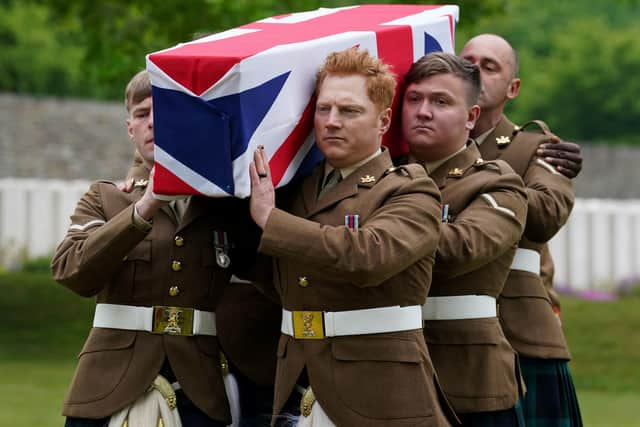Northern Ireland link to soldier buried century after war death
and live on Freeview channel 276
Private William Johnston, of the 7th Battalion of the Royal Scots Fusiliers, and an unidentified soldier who served in the East Yorkshire Regiment were buried on Thursday at the Loos British Cemetery in France.
The service was led by the Reverend Dave Jeal, chaplain to 2nd Battalion Royal Regiment of Scotland, and bearer parties were provided by the Yorkshire Regiment and the Royal Regiment of Scotland.
Advertisement
Hide AdAdvertisement
Hide AdThe two soldiers were killed on September 26, 1915, during the largest British attack of the year, and their remains were not discovered until 2018.


The remains of Pte Johnston, who was 39 when he died, were found during routine First World War ordinance surveys at a hospital building site in Lens.
Nicola Nash, of the Ministry of Defence’s Joint Casualty and Compassionate Centre, said: “We were lucky with Johnston because he was actually discovered with a spoon that had his service number on it. So we were able to look at that service number and link it with Johnston.
“Looking through historical documents, it also confirmed that the regiment was in the area when he was killed.”
Advertisement
Hide AdAdvertisement
Hide AdRecords showed he was the only casualty with the number who did not have a known burial place. Sharon Williamson, his great-great-niece, was then contacted by the MoD unit, known as the war detectives.
They asked for a DNA sample from her, which confirmed his identity.
The 48-year-old, of Co Armagh, said: “It really brings ‘Lest we forget’ right into people’s faces, and that over 100 years ago that these men are not forgotten about and they’re given the respect and the military burial that they deserve. It really brings home that these people can never be forgotten.”
She added she heard his name being read out every year as it is on a local war memorial in Richhill.
Advertisement
Hide AdAdvertisement
Hide AdShe added: “We knew of the name but we didn’t know of the story, we didn’t know where he died, we didn’t know when he died, we didn’t know what age he was.”
But the identity, and the story, of his fellow soldier in the East Yorkshire Regiment remains a mystery.
He was found wearing two East Yorkshire Regiment shoulder titles.
The war diaries of his regiment confirm that on September 26, 1915, they were in the location where his remains were recovered.
Advertisement
Hide AdAdvertisement
Hide AdOn that day the regiment suffered heavy causalities from machine gun fire, having launched an attack the previous day.
Between September 25 and 27, the regiment lost 15 officers and 266 other ranks, making it impossible for the war detectives to identify the soldier by name.